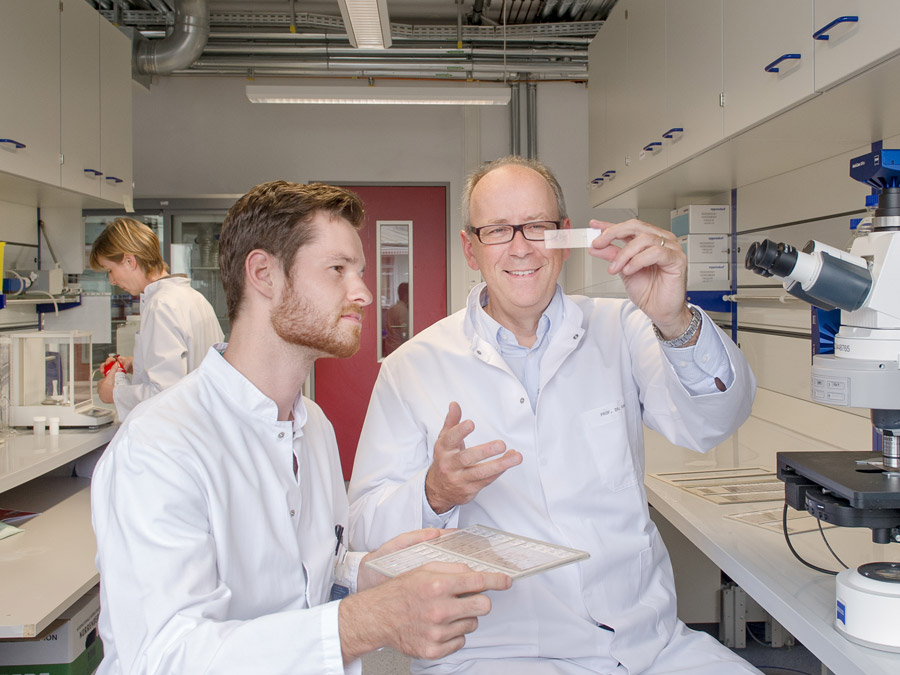Fast, direct route: New signaling pathway discovered for T cell activation in the liver
Synthetic messenger boosts immune system

When a pathogen attacks a healthy cell in the body, T lymphocytes are tasked with identifying and destroying the infected cell. Scientists know that they undergo a “training program” for this task in the lymph nodes or the spleen. “Programming cells” play a key role here, presenting pathogen constituents to the T lymphocytes. This is how the T lymphocytes learn to recognize these components and become specialized “killer” cells. Research teams led by Prof. Percy Knolle from Klinikum rechts der Isar and the University of Bonn and Prof. Stefan Rose-John from the University of Kiel have now discovered a second site where T lymphocytes can be programmed to attack pathogens.
The researchers identified the liver as an immunological organ where special tissue cells act as “programming cells” to prepare the T lymphocytes for their battle against infected cells. They were also able to decrypt the exact molecular code used by these tissue cells to equip the T lymphocytes with special infection-fighting capabilities. “This new mechanism is particularly interesting because the T cells are activated directly and very rapidly – in just 18 hours instead of 72,” explains Percy Knolle.
Synthetic messenger as new adjuvant
The key to all this is a natural messenger from the interleukin family: IL-6/sIL-6R. It only becomes effective when the two individual components (IL-6 and sIL-6R) combine. Previously, scientists were only aware of a role for the substance in regeneration and the development of inflammatory responses. But now the research teams have shown that the T lymphocytes in the liver engage in direct contact with the “programming cells” found there, and that IL-6/sIL-6R very efficiently activates the T cells.
Once the researchers had uncovered this new mechanism, they were able to use a synthetic designer messenger developed by Stefan Rose-John, known as Hyper-IL-6, for the targeted stimulation of T lymphocytes. In this construct, the two individual components which are normally separated are directly and firmly linked to each other. “In combination with the familiar stimulation mechanisms of the T lymphocytes, Hyper-IL-6 can be used to effect a specific ‘hyper stimulation’ of T lymphocytes for particular therapeutic purposes. This could be an important step in helping us improve vaccine formulations,” adds Percy Knolle.
As well as components of the pathogen, current vaccines also contain substances known as adjuvants. After a few intermediate steps, adjuvants indirectly activate the T lymphocytes and help to build up immunity. “We are placing high hopes on hyper-IL-6 as an effective new adjuvant capable of activating T cells directly and thus more rapidly. This could for example help us tackle chronic bacterial or viral infections which have not previously responded to vaccinations,” he concludes.
Original publication
Böttcher J.P., Schanz O., Garbers C., Zaremba A., Hegenbarth S., Kurts C., Beyer M., Schultze J.L., Kastenmüller W., Rose-John S., and Knolle P.A., IL-6 trans-Signaling-Dependent Rapid Development of Cytotoxic CD8+ T Cell Function, Cell Reports, 2014.
DOI: 10.1016/j.celrep.2014.07.008
Contact
Prof. Dr. Percy Knolle
Institute of Molecular Immunology/Experimental Oncology
Klinikum rechts der Isar, Technische Universität München
Tel.: +49 (0)89 4140-6921
percy.knolle@tum.de
www.imi.med.tum.de
Technical University of Munich
Corporate Communications Center
- Dr. Vera Siegler
- vera.siegler@tum.de
- presse@tum.de
- Teamwebsite